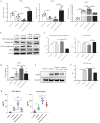Unveiling the potent effect of vitamin D: harnessing Nrf2/HO-1 signaling pathways as molecular targets to alleviate urban particulate matter-induced asthma inflammation
- PMID: 38273268
- PMCID: PMC10809564
- DOI: 10.1186/s12890-024-02869-2
Unveiling the potent effect of vitamin D: harnessing Nrf2/HO-1 signaling pathways as molecular targets to alleviate urban particulate matter-induced asthma inflammation
Abstract
Background: Asthma is the most common allergic disease characterized by an inflammatory response in the airways. Mechanismly, urban particulate matter (PM) is the most widely air pollutant associated with increased asthma morbidity and airway inflammation. Current research found that vitamin D is an essential vitamin with anti-inflammatory, antioxidant and other medical efficacy. Inadequate or deficient vitamin D often leads to the pathogenesis and stability of asthma. NGF exacerbates airway inflammation in asthma by promoting smooth muscle cell proliferation and inducing the Th2 immune response. Activation of the Nrf2/HO-1 signaling pathway can exert a protective effect on the inflammatory response in bronchial asthma. However, the specific mechanism of this pathway in PM-involved asthmatic airway smooth muscle cells remains unclear.
Methods: Mice were sensitized and challenged with Ovalbumin (OVA) to establish an asthma model. They were then exposed to either PM, vitamin D or a combination of both, and inflammatory responses were observed. Including, acetylcholine stimulation at different concentrations measured airway hyperresponsiveness in mice. Bronchoalveolar lavage fluid (BALF) and serum were collected for TNF-α, IL-1β, IL-6, and Nerve growth factor (NGF) analysis. Additionally, lung tissues underwent histopathological examination to observe alveolar structure and inflammatory cell infiltration. Specific ELISA kits were utilized to determine the levels of the inflammatory factors TNF-α, IL-1β, IL-6, and Nerve growth factor (NGF). Nrf2/HO-1 signaling pathways were examined by western blot analysis. Meanwhile, we constructed a cell system with low HO-1 expression by lentiviral transfection of airway smooth muscle cells. The changes of Nrf2, HO-1, and NGF were observed after the treatment of OVA, PM, and Vit D were given.
Results: The in vivo results showed that vitamin D significantly alleviated pathological changes in lung tissue of PM-exposed mice models. Mechanismly, vitamin D decreased substantial inflammatory cell infiltration in lung tissue, as well as the number of inflammatory cells in BALF. Furthermore, vitamin D reduced the heightened inflammatory factors including of TNF-α, IL-1β, IL-6, and NGF caused by PM exposure, and triggered the activity of nucleus Nrf2 and HO-1 in PM-exposed asthmatic mice. Notably, knockdown HO-1 weakens the Vitamin D- mediated inhibition to pollution toxicity in asthma. Importantly, in vitro experiments on OVA-stimulated mice airway smooth muscle cells, the results showed that OVA and PM, respectively, reduced Nrf2/HO-1 and increased NGF's expression, while vitamin D reversed the process. And in the HO-1 knockdown cell line of Lenti-si-HO-1 ASMCs, OVA and PM reduced Nrf2's expression, while HO-1 and NGF's expression were unchanged.
Conclusions: The above results demastrate that vitamin D downregulated the inflammatory response and the expression of NGF by regulating the Nrf2/HO-1 signaling pathways in airway smooth muscle cells, thereby showing potent anti-inflammatory activity in asthma.
Keywords: Asthma; HO-1; Nerve growth factor; Particulate matters; Vitamin D.
© 2024. The Author(s).
Conflict of interest statement
The authors declare no competing interests.
Figures




Similar articles
-
Aloperine suppresses allergic airway inflammation through NF-κB, MAPK, and Nrf2/HO-1 signaling pathways in mice.Int Immunopharmacol. 2018 Dec;65:571-579. doi: 10.1016/j.intimp.2018.11.003. Epub 2018 Nov 8. Int Immunopharmacol. 2018. PMID: 30415164
-
Protective effects of Angelica decursiva Franchet & Savatier on allergic responses through enhancement of Nrf2 and suppression of NF-kB/MMP-9 in ovalbumin-exposed mice.J Ethnopharmacol. 2024 Jan 10;318(Pt A):116863. doi: 10.1016/j.jep.2023.116863. Epub 2023 Jul 7. J Ethnopharmacol. 2024. PMID: 37423516
-
Fine Particulate Matter-Induced Exacerbation of Allergic Asthma via Activation of T-cell Immunoglobulin and Mucin Domain 1.Chin Med J (Engl). 2018 Oct 20;131(20):2461-2473. doi: 10.4103/0366-6999.243551. Chin Med J (Engl). 2018. PMID: 30334531 Free PMC article.
-
Vitamin D in Asthma: Mechanisms of Action and Considerations for Clinical Trials.Chest. 2018 May;153(5):1229-1239. doi: 10.1016/j.chest.2017.09.005. Epub 2017 Sep 18. Chest. 2018. PMID: 28923762 Review.
-
Targeting epigenetic and post-translational modifications of NRF2: key regulatory factors in disease treatment.Cell Death Discov. 2025 Apr 21;11(1):189. doi: 10.1038/s41420-025-02491-z. Cell Death Discov. 2025. PMID: 40258841 Free PMC article. Review.
Cited by
-
Evaluating the Prophylactic and Nephroprotective Effects of Vitamin D and Metformin in Diabetic Nephropathy.Oxid Med Cell Longev. 2025 Jul 26;2025:5370323. doi: 10.1155/omcl/5370323. eCollection 2025. Oxid Med Cell Longev. 2025. PMID: 40756379 Free PMC article.
-
Association of 25(OH)D serum level with biological aging: A Cross-Sectional Study of 2007-2016 NHANES surveys.PLoS One. 2025 Aug 6;20(8):e0328107. doi: 10.1371/journal.pone.0328107. eCollection 2025. PLoS One. 2025. PMID: 40768409 Free PMC article.
-
Causal association between circulating cytokine levels and the risk for asthma: A bidirectional, Mendelian randomization study.Medicine (Baltimore). 2025 Jul 18;104(29):e43364. doi: 10.1097/MD.0000000000043364. Medicine (Baltimore). 2025. PMID: 40696647 Free PMC article.
References
-
- Edginton S, O’Sullivan DE, King WD, Research MLJE. The effect of acute outdoor air pollution on peak expiratory flow in individuals with asthma: a systematic review and meta-analysis. 2021, 192:110296. - PubMed
-
- Faraji M, Mohammadi A, Ajmi N, Fallahnezhad M, Sabetkish M, Kazemnejad N, Shoormasti A, Fazlollahi RS, Pourpak MR, Moin Z. M: Exposure to ambient air pollution and prevalence of asthma in adults. 2021.
MeSH terms
Substances
Grants and funding
- 2020J011232/the Natural Science Foundation of Fujian Province
- 2020J011232/the Natural Science Foundation of Fujian Province
- 2020J011232/the Natural Science Foundation of Fujian Province
- 2020J011232/the Natural Science Foundation of Fujian Province
- YDZX20193502000003/the Fundamental Research Funds for the Key Medical and Health Projects in Xiamen
LinkOut - more resources
Full Text Sources
Medical

